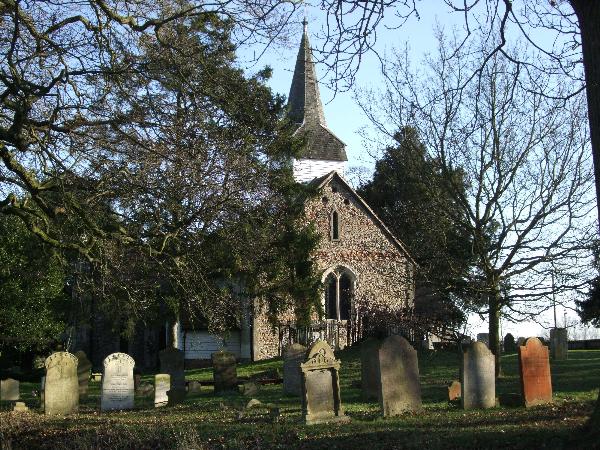St Peter and St Paul, Stondon Massey

The
church
of
St Peter and St Paul
consists of nave, chancel, north
vestry, organ chamber and chapel, south porch, and western bell
turret with spire. The nave and chancel date from about 1100, the
bell turret and the porch were added in the 15th century and in the
19th century the vestry, organ chamber and chapel were added and
the porch rebuilt. The walls are mainly plastered over outside but
where exposed at the west end are seen to be of neatly coursed
flints with lacing courses of tiles, possibly Roman.
Of the original
structure, apart from the walls, there remain two characteristic
narrow Norman window openings (one now blocked externally) in the
north side of the nave, one in the south side of the nave and one
in the south wall of the chancel. The south doorway is also of that
period. It has an unornamented stone surround with rough, quoined
jambs and rudimentary impost blocks. A north doorway of similar
date was in use until 1850 but is now blocked externally. Other
features which may in part be survivals from the original building
are the narrow lancet shaped window and three small circular
openings in the western gable of the nave. The original chancel was
probably apse-ended.
Late in the 14th century
a two-light traceried window was added to the south wall of the
chancel and a similar window of three lights to the south wall of
the nave. It was possibly at the same period that the chancel-arch
was removed and the apse replaced by a square end.
Early in the 15th
century there were further considerable alterations, including the
reconstruction of the roof, the addition of the bell turret and
south porch and the insertion of a new west window. The roof (now
ceiled) has heavy moulded wall plates with three king-post trusses
over the nave portion. The bell turret rises from the west end of
the nave and is carried on stout chamfered corner posts from the
ground with ornamental bracing in which the western-most rooftruss
is incorporated. Externally the bell turret is rectangular and
weather-boarded with a short octagonal broach spire covered with
shingles. It was rebuilt in 1888. The west window is of two
lights with traceried head within a four-centered arch. The porch,
which was reconstructed in the 19th century, retains one original
cambered beam with plate, posts, and braces.
The chancel screen dates
from the late 15th century. It has five narrow bays with traceried
agree arches on each side of a wider central opening with a
four-centre arched head. It has been much restored, especially in
the lower part.
Extensive alterations
and repairs were begun in 1850. Further extensions were made in
1873-4, these included a new vestry with heating cellar beneath, an
organ chamber, and a mortuary chapel. The chapel consists of two
bays vaulted in stone in Early English style, with lancet and
three-light traceried windows. Externally it is faced with random
flint work with stone dressings and has a gable at the north end
with an arched doorway and angle buttresses. The chapel is entered
from the nave, from which it is divided by a glazed screen, and the
organ chamber from the chancel, both through wide arches the
construction of which occasioned the removal of a Norman window in
the chancel. The abutment of the west wall of the chapel against
the nave caused another Norman window to be blocked up.
The last major repairs to the
church were those of 1888, when the bell-turret and spire were
rebuilt.
The pulpit is octagonal
and has panelled sides with arabesque ornament, and inside it is '2
TIM. 4. 2.' The reading-desk, also panelled and carved with jewel
ornament, bears the date 1630. The pulpit and the desk were
previously combined in three-decker fashion but were separated
during the restorations of 1850.
There are three bells. The
oldest, which was probably installed when the belfry was built, was
made by John Bird early in the 15th century: this is the second in
the peal, and is inscribed 'Johannes Cristi Care Dignare Pro Nobis
Orare'. The first in the peal is by Robert Mot, 1588, and the third
by Thomas Gardiner, 1737.
The monuments include
two notable sets of brasses. The first, in the north-eastern corner
of the chancel, is to John Carre, 1570, ironmonger and Merchant
Adventurer of London, and shows him flanked by his two wives, with
the shields of arms of the City of
London
, the Ironmongers' Company and the Merchant Adventurers, and
Carre's own monogram. This is currently covered by carpet but is
exposed occasionally; however there is a rubbing of it in the
vestry. The second, now on the north wall of the nave, was formerly
in the chancel: it is to Rainold Hollingworth, 1573, and shows him
in armour with his wife beside him. This is a palimpsest on earlier
Flemish brasses, the patterns of which survive on the backs of the
figures
On the south wall of the nave is
an enriched stone memorial in Jacobean style to William Byrd the
musician (d. 1623). It was erected in 1923 to mark the tercentenary
of his death. There is a facsimile of Byrd’s will in the
vestry.
The cache
You’re looking for a 35mm film
canister. The cache has a log book but no pen so please bring one
with you.
Church Micro Series
If any body would like to expand
to this series please do, could you please let sadexploration know
first so he can keep track of the Church numbers and names to avoid
duplication.